Fibrx Rocking Chair: Design and Application of Tailored Timber as an Embedded Frame for Natural Fibre-Reinforced Polymer (NFRP) Coreless Winding
Abstract
1. Introduction
2. Materials and Methods
2.1. Materials
2.1.1. Timber Veneer
2.1.2. Flax Fibre-Reinforced Composite
2.2. Methods
2.2.1. Design Process
2.2.2. Tailoring Timber Veneer
Lamination Bending Test 1: Single Strip
Lamination Bending Test 2: Combined
2.2.3. Tailoring Flax FRP
2.2.4. Timber and FRP Connections: Anchor Point Development
2.2.5. Fabrication
3. Results
3.1. Material Usage
3.2. Prototype Simulation
3.3. Benchmarking Results
4. Discussion
Author Contributions
Funding
Institutional Review Board Statement
Informed Consent Statement
Data Availability Statement
Acknowledgments
Conflicts of Interest
References
- European Commission. Roadmap to a Resource Efficient Europe COM (2011) 571. 2011. Available online: https://www.eea.europa.eu/policy-documents/com-2011-571-roadmap-to (accessed on 20 July 2022).
- Pomponi, F.; Moncaster, A. Embodied carbon mitigation and reduction in the built environment—What does the evidence say? J. Environ. Manag. 2016, 181, 687–700. [Google Scholar] [CrossRef] [PubMed]
- Prado, M.; Dorstelmann, M.; Schwinn, T.; Menges, A.; Knippers, J. Core-Less Filament Winding: Robotically Fabricated Fiber Composite Building Components In Robotic Fabrication in Architecture, Art and Design 2014; McGee, W., Ponce de Leon, M., Eds.; Springer International Publishing: Cham, Switzerland, 2014; pp. 275–289. [Google Scholar]
- Reichert, S.; Schwinn, T.; La Magna, R.; Waimer, F.; Knippers, J.; Menges, A. Fibrous structures: An integrative approach to design computation, simulation and fabrication for lightweight, glass and carbon fibre composite structures in architecture based on biomimetic design principles. Comput.-Aided Des. 2014, 52, 27–39. [Google Scholar] [CrossRef]
- Doerstelmann, M.; Knippers, J.; Menges, A.; Parascho, S.; Prado, M.; Schwinn, T. ICD/ITKE Research Pavilion 2013-14: Modular Coreless Filament Winding Based on Beetle Elytra: ICD/ITKE Research Pavilion 2013–2014: Modular Coreless Filament Winding Based on Beetle Elytra. Archit. Des. 2015, 85, 54–59. [Google Scholar]
- Prado, M.; Doerstelmann, M.; Solly, J.; Menges, A.; Knippers, J. Elytra Filament Pavilion: Robotic filament winding for structural composite building systems. In Fabricate 2017: Rethinking Design and Construction (JSTOR); UCL Press: London, UK, 2017; pp. 224–231. [Google Scholar]
- Dahy, H. Natural Fibre-Reinforced Polymer Composites (NFRP) Fabricated from Lignocellulosic Fibres for Future Sustainable Architectural Applications, Case Studies: Segmented-Shell Construction, Acoustic Panels, and Furniture. Sensors 2019, 19, 738. [Google Scholar] [CrossRef] [PubMed]
- Dahy, H. ‘Materials as a Design Tool’ Design Philosophy Applied in Three Innovative Research Pavilions Out of Sustainable Building Materials with Controlled End-Of-Life Scenarios. Buildings 2019, 9, 64. [Google Scholar] [CrossRef]
- Dahy, H.; Baszyński, P.; Petrš, J. Experimental Biocomposite Pavilion: Segmented Shell Construction—Design, Material Development and Erection. In Proceedings of the ACADIA 2019—Ubiquity and Autonomy, Austin, TX, USA, 21–26 October 2019; pp. 156–165. [Google Scholar]
- Dambrosio, N.; Zechmeister, C.; Bodea, S.; Koslowski, V.; Gil-Pérez, M.; Rongen, B.; Knippers, J.; Menges, A. Buga Fibre Pavilion: Towards an architectural application of novel fiber composite building systems. In Proceedings of the ACADIA 2019—Ubiquity and Autonomy, Austin, TX, USA, 21–26 October 2019; pp. 140–149. [Google Scholar]
- Dambrosio, N.; Zechmeister, C.; Estrada, R.D.; Kannenberg, F.; Peréz, M.G.; Schlopschnat, C.; Rinderspacher, K.; Knippers, J.; Menges, A. Design and development of an FRP-Timber hybrid building system for multi-story applications in architecture. In Proceedings of the ACADIA 2021—Realignments, Online, 3–6 November 2021; pp. 2–11. [Google Scholar]
- Zechmeister, C.; Bodea, S.; Dambrosio, N.; Menges, A. Design for Long-Span Core-Less Wound, Structural Composite Building Elements. In Impact: Design With All Senses; Gengnagel, C., Baverel, O., Burry, J., Ramsgaard Thomsen, M., Weinzierl, S., Eds.; Springer International Publishing: Cham, Germany, 2019; pp. 401–415. [Google Scholar]
- Costalonga Martins, V.; Cutajar, S.; van der Hoven, C.; Baszyński, P.; Dahy, H. FlexFlax Stool: Validation of Moldless Fabrication of Complex Spatial Forms of Natural Fiber-Reinforced Polymer (NFRP) Structures through an Integrative Approach of Tailored Fiber Placement and Coreless Filament Winding Techniques. Appl. Sci. 2020, 10, 3278. [Google Scholar] [CrossRef]
- Rihaczek, G.; Klammer, M.; Başnak, O.; Petrš, J.; Grisin, B.; Dahy, H.; Carosella, S.; Middendorf, P. Curved Foldable Tailored Fiber Reinforcements for Moldless Customized Bio-Composite Structures. Proof of Concept: Biomimetic NFRP Stools. Polymers 2020, 12, 2000. [Google Scholar] [CrossRef] [PubMed]
- Gil Pérez, M.; Guo, Y.; Knippers, J. Integrative material and structural design methods for natural fibres filament-wound composite structures: The LivMatS pavilion. Mater. Des. 2022, 217, 110624. [Google Scholar] [CrossRef]
- van der Werf HM, G.; Turunen, L. The environmental impacts of the production of hemp and flax textile yarn. Ind. Crops Prod. 2008, 27, 1–10. [Google Scholar] [CrossRef]
- González-García, S.; Hospido, A.; Feijoo, G.; Moreira, M.T. Life cycle assessment of raw materials for non-wood pulp mills: Hemp and flax. Resour. Conserv. Recycl. 2010, 54, 923–930. [Google Scholar] [CrossRef]
- Horn, R.; Dahy, H.; Gantner, J.; Speck, O.; Leistner, P. Bio-Inspired Sustainability Assessment for Building Product Development—Concept and Case Study. Sustainability 2018, 10, 130. [Google Scholar] [CrossRef]
- Felbrich, B.; Solly, J. An Integrative Design Process Utilising an Autonomous UAV and Industrial Robots for the Fabrication of Long-Span Composite Structures. In Proceedings of the ACADIA 2017—Disciplines + Disruption, Massachusetts Institute of Technology, Cambridge, MA, USA, 2–4 November 2017; pp. 248–259. [Google Scholar]
- Solly, J.; Knippers, J.; Dörstelmann, M. Coreless Filament Winding: From Academia to Practice. In Design Transactions: Rethinking Information Modelling for a New Material Age (JSTOR); UCL Press: London, UK, 2020; pp. 114–121. [Google Scholar]
- Gil Pérez, M.; Früh, N.; La Magna, R.; Knippers, J. Integrative structural design of a timber-fibre hybrid building system fabricated through coreless filament winding: Maison Fibre. J. Build. Eng. 2022, 49, 104114. [Google Scholar] [CrossRef]
- Schwinn, T.; Krieg, O.D.; Menges, A. A Textile Approach Towards the Computational Design and Fabrication of Lightweight Timber Shells. In Proceeding of the ACADIA 2016—Posthuman Frontiers, Ann Arbor, MI, USA, 27–29 October 2016; pp. 224–233. [Google Scholar]
- Quanjin, M.; Rejab MR, M.; Idris, M.S.; Kumar, N.M.; Merzuki, M.N.M. Robotic Filament Winding Technique (RFWT) in Industrial Application: A Review of State of the Art and Future Perspectives. Int. Res. J. Eng. Technol. 2018, 5, 1668–1676. [Google Scholar]
- Shaw-Stewart, D. Filament winding—Materials & engineering. Mater. Des. 1985, 6, 140–144. [Google Scholar]
- Mindermann, P.; Pérez, M.G.; Knippers, J.; Gresser, G.T. Investigation of the Fabrication Suitability, Structural Performance, and Sustainability of Natural Fibers in Coreless Filament Winding. Materials 2022, 15, 3260. [Google Scholar] [CrossRef] [PubMed]
- Gil Pérez, M.; Zechmeister, C.; Menges, A.; Knippers, J. 2022 Coreless filament-wound structures: Toward performative long- span and sustainable building systems. In Proceedings of the IASS 2022 Symposium Affiliated with APCS 2022 Conference, Beijing, China, 19–23 September 2022. [Google Scholar]
- Gil Pérez, M.G.; Rongen, B.; Koslowski, V.; Knippers, J. Structural design assisted by testing for modular coreless filament-wound composites: The BUGA Fibre Pavilion. Constr. Build. Mater. 2021, 301, 124303. [Google Scholar] [CrossRef]
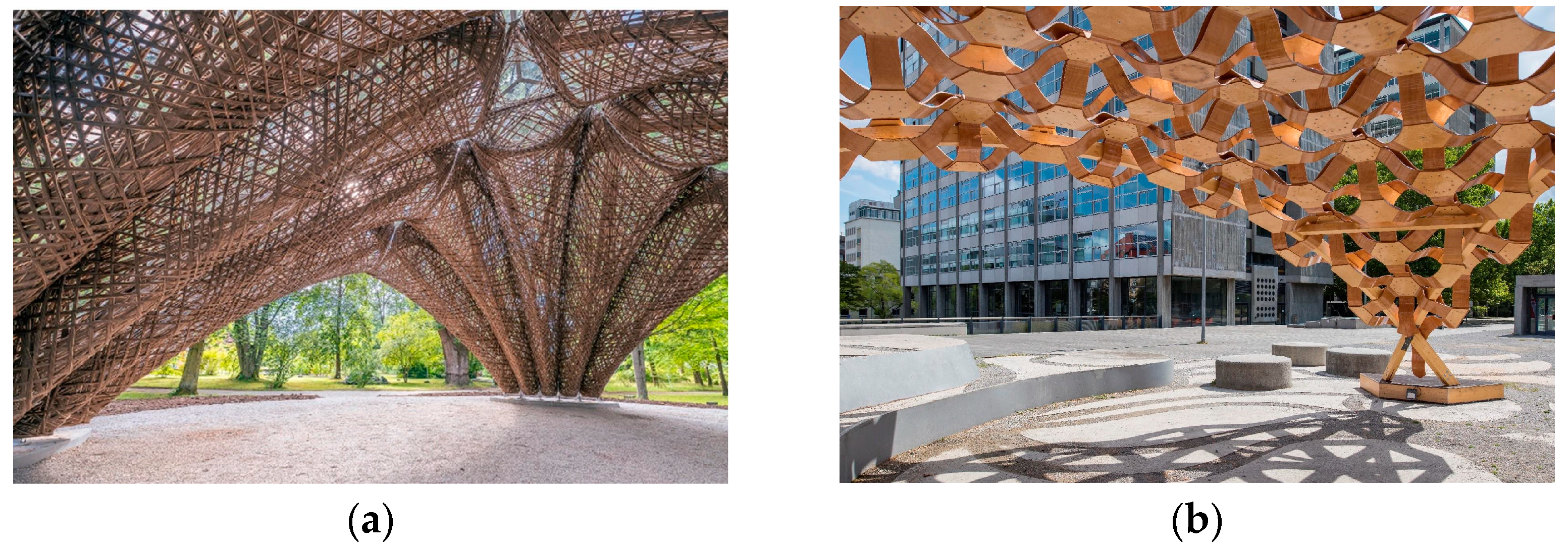

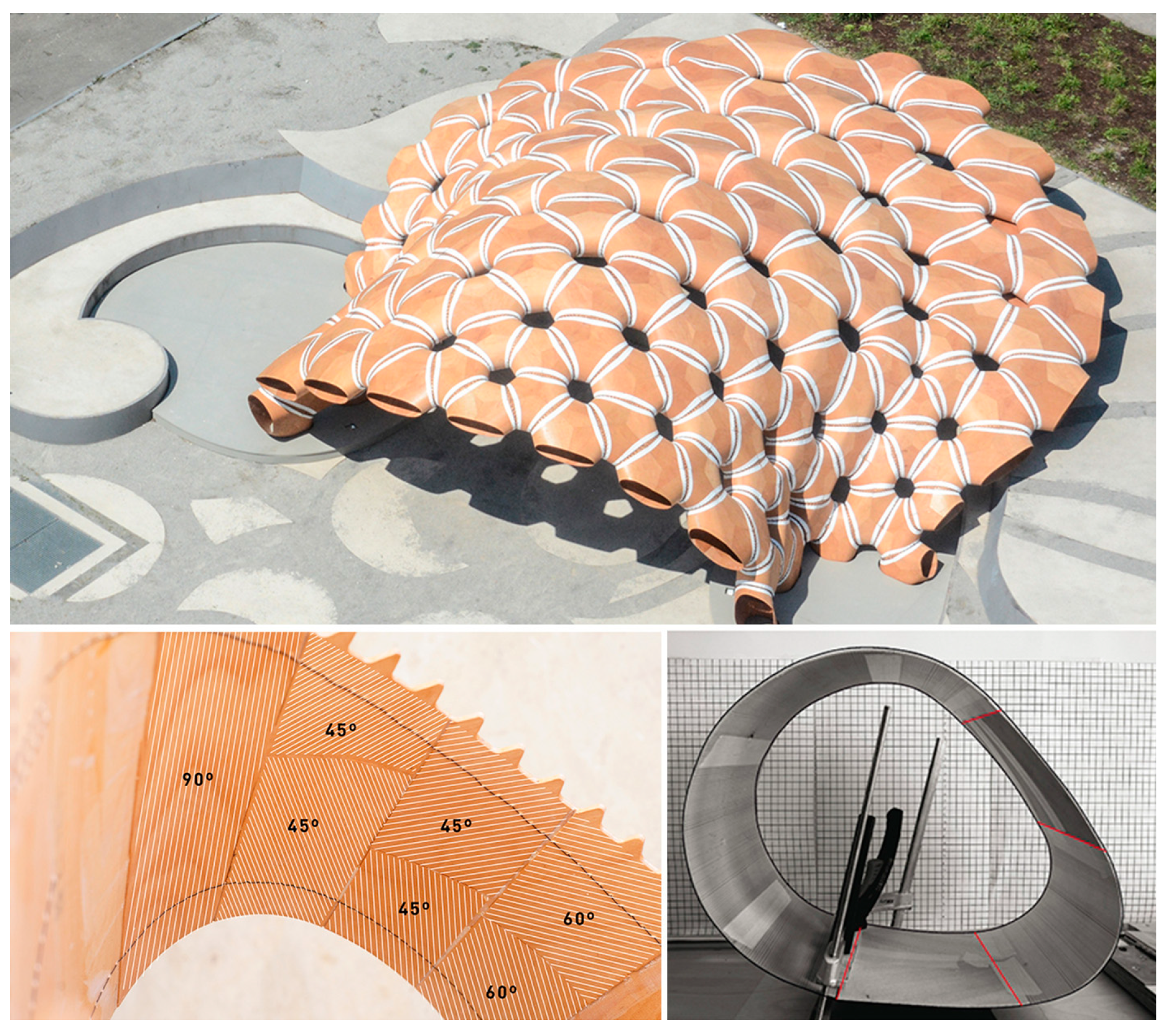



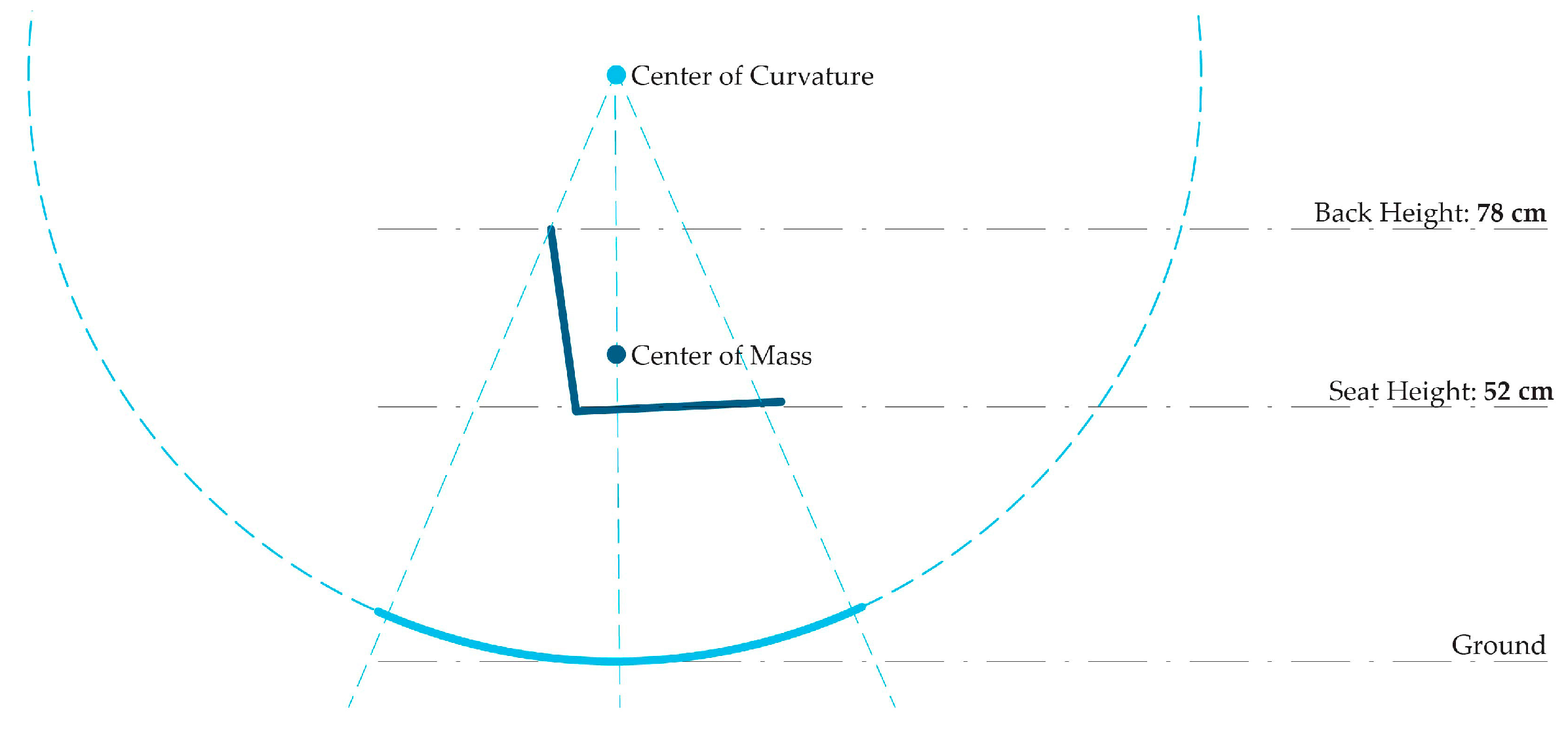
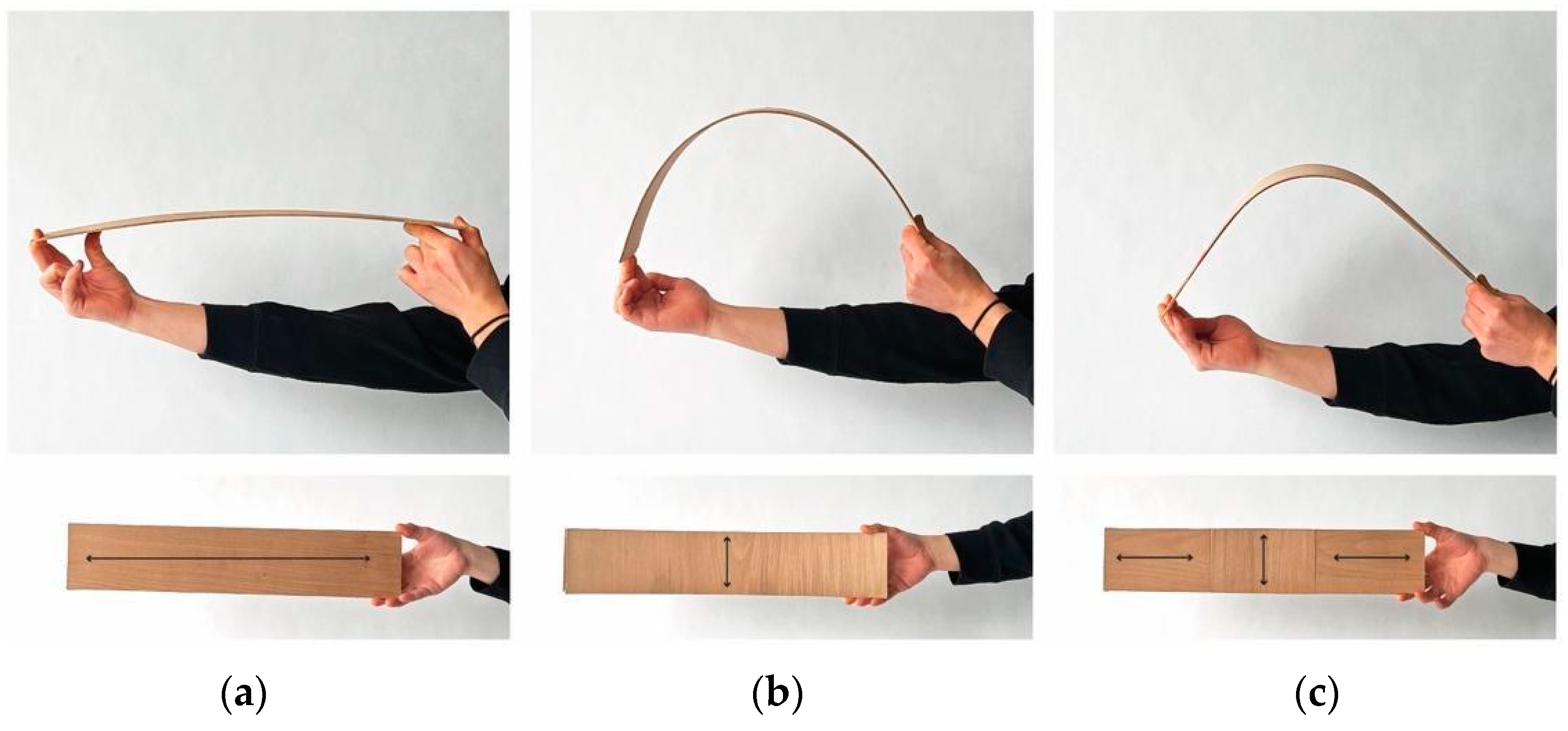
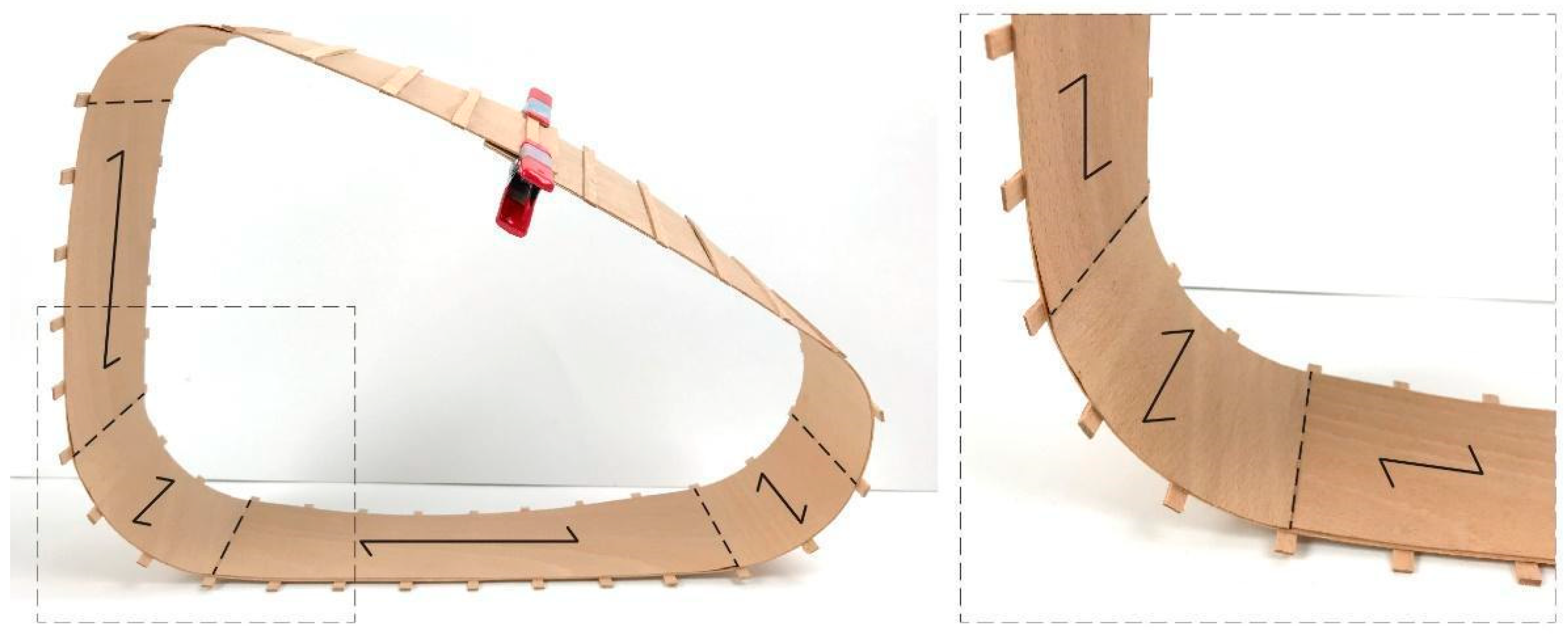
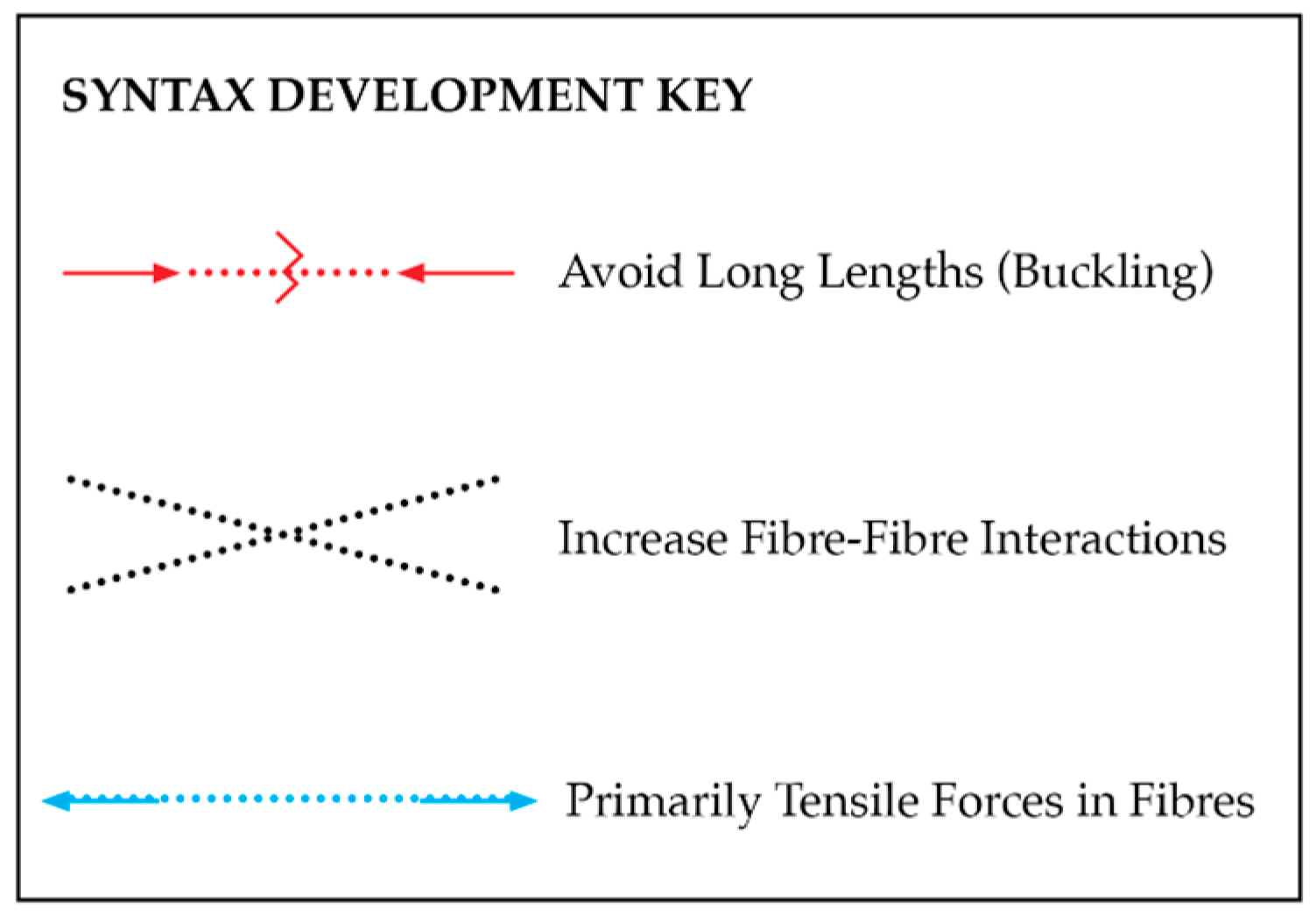


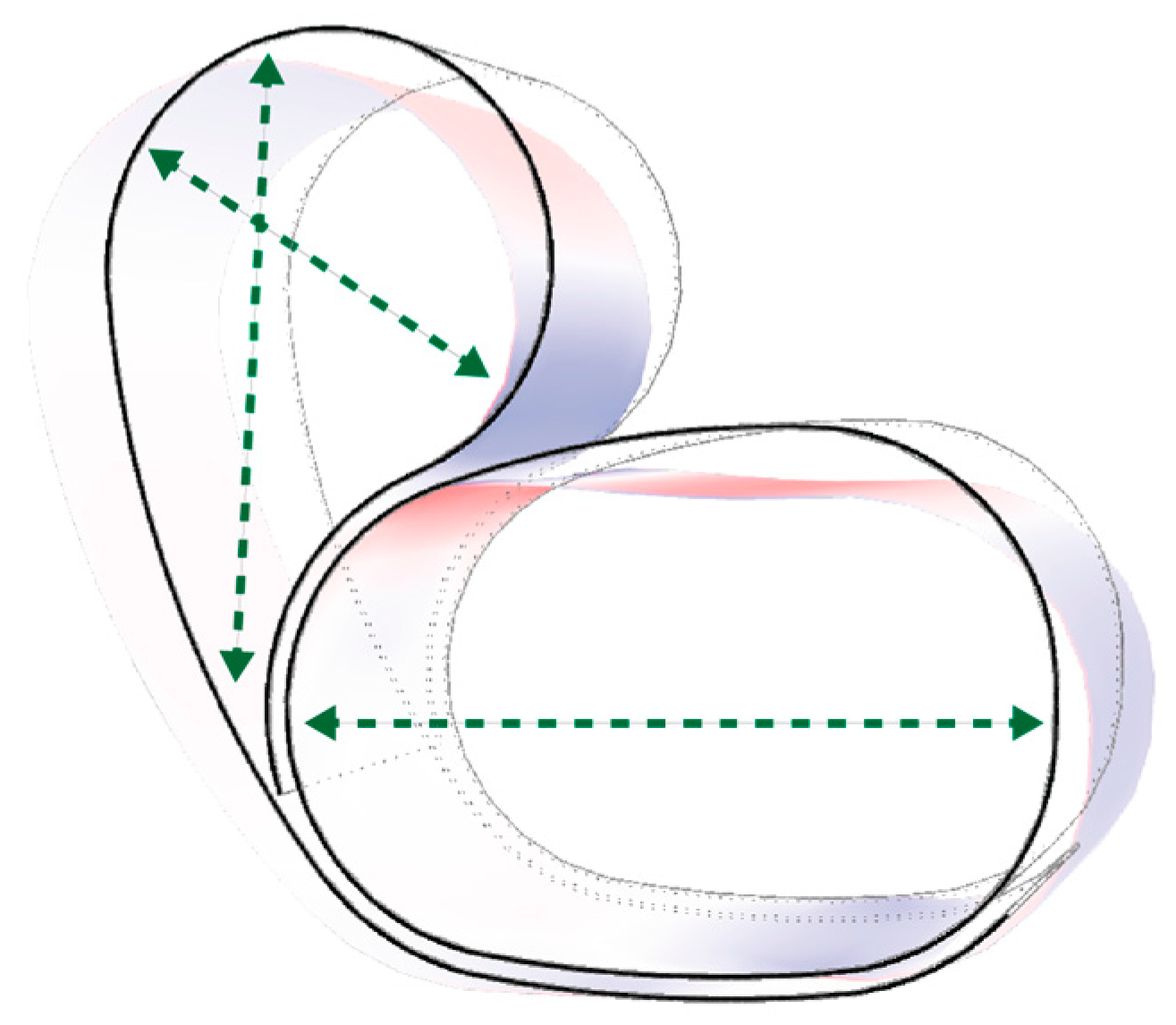
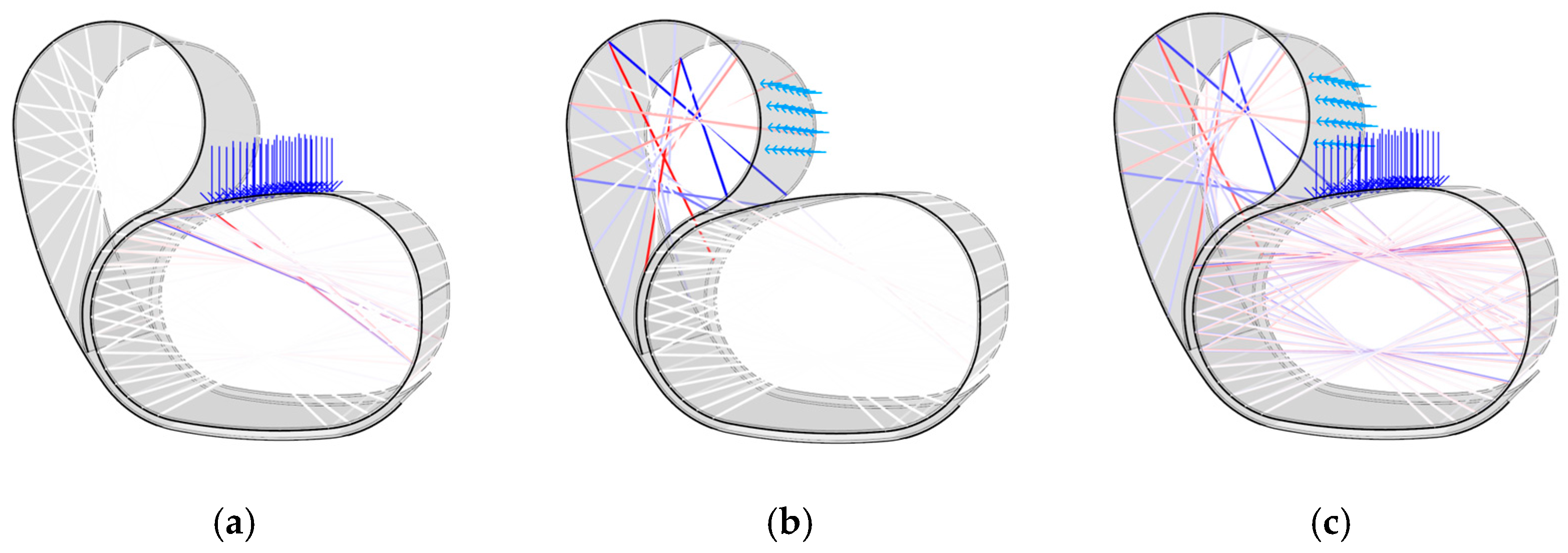



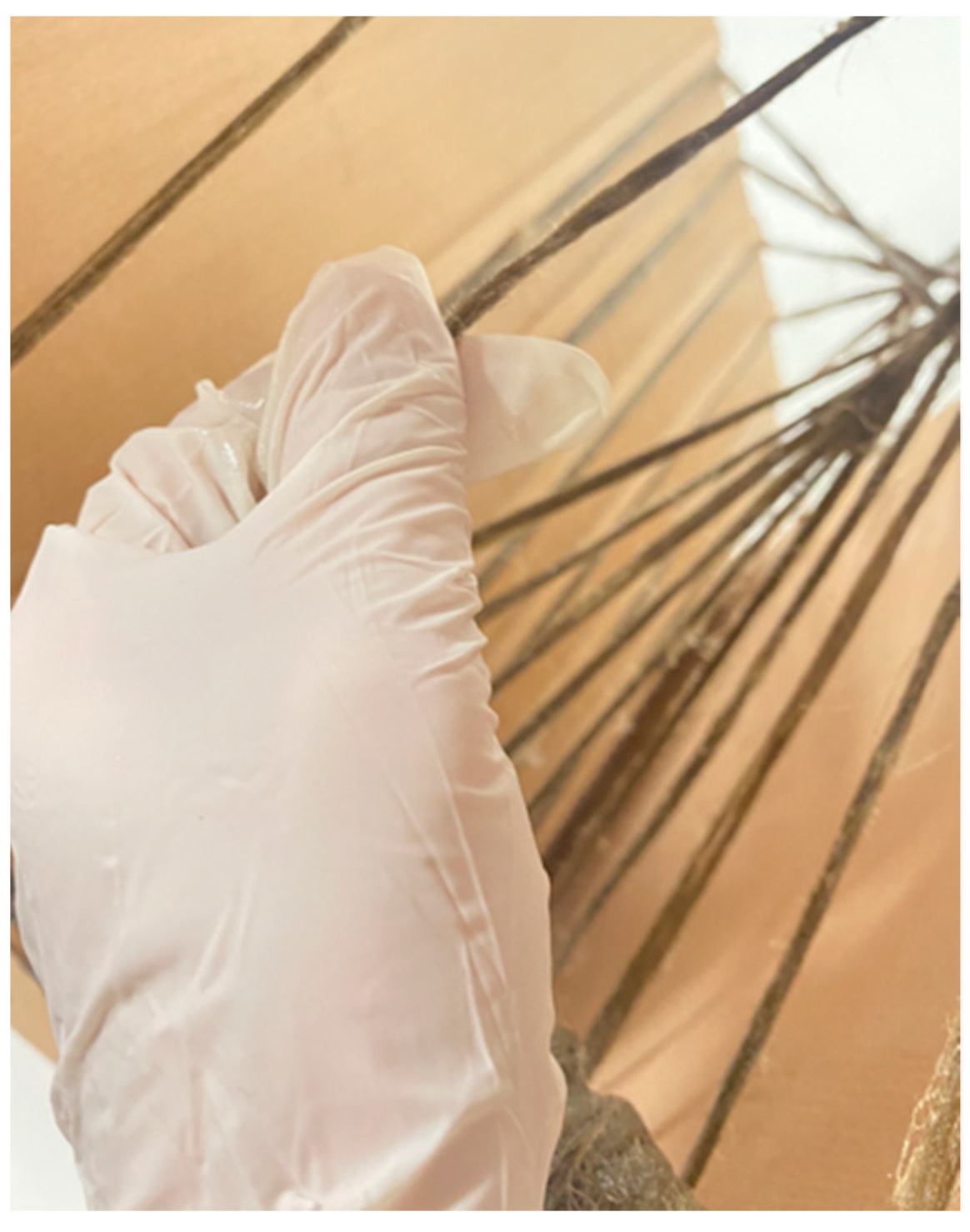
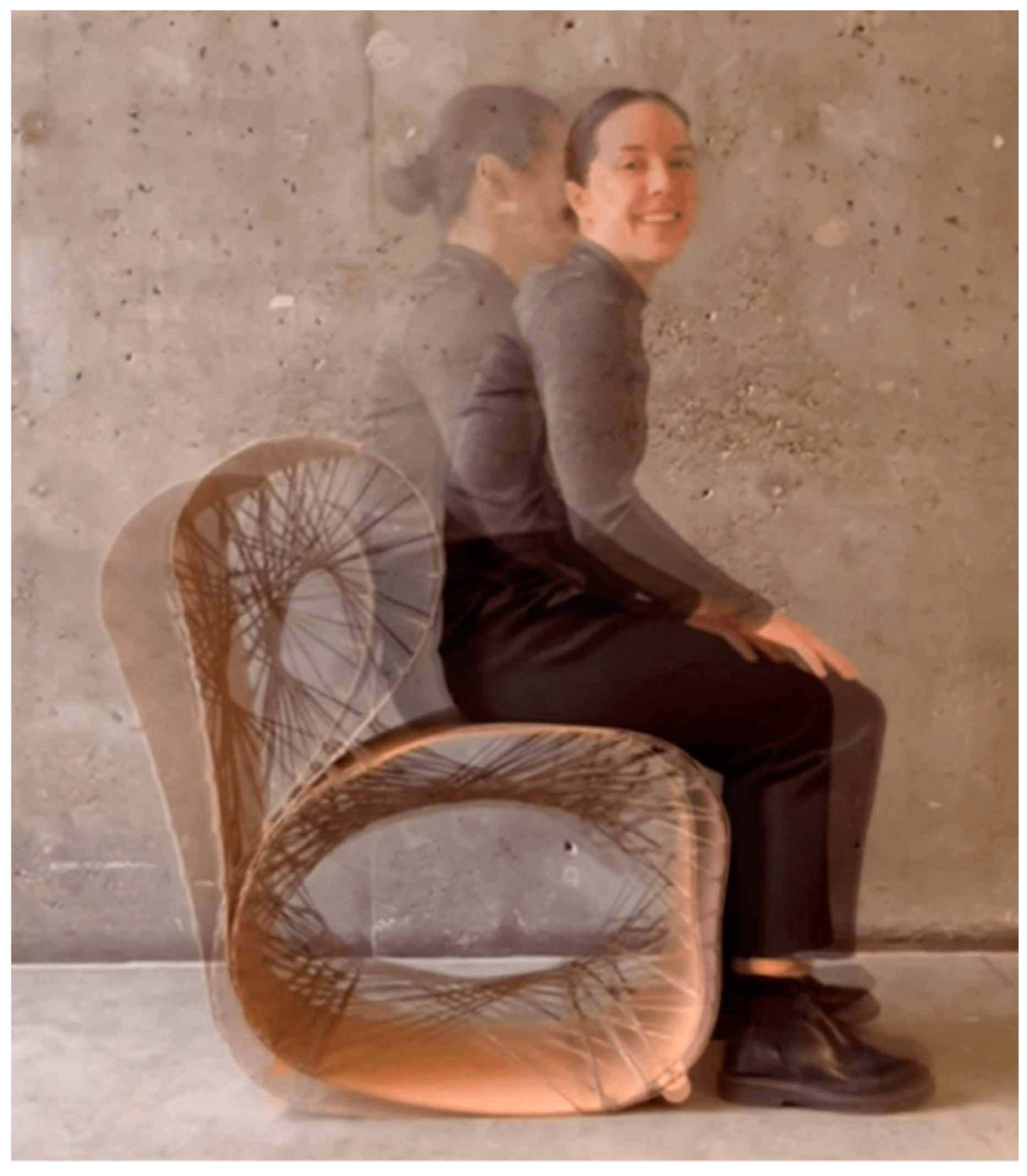
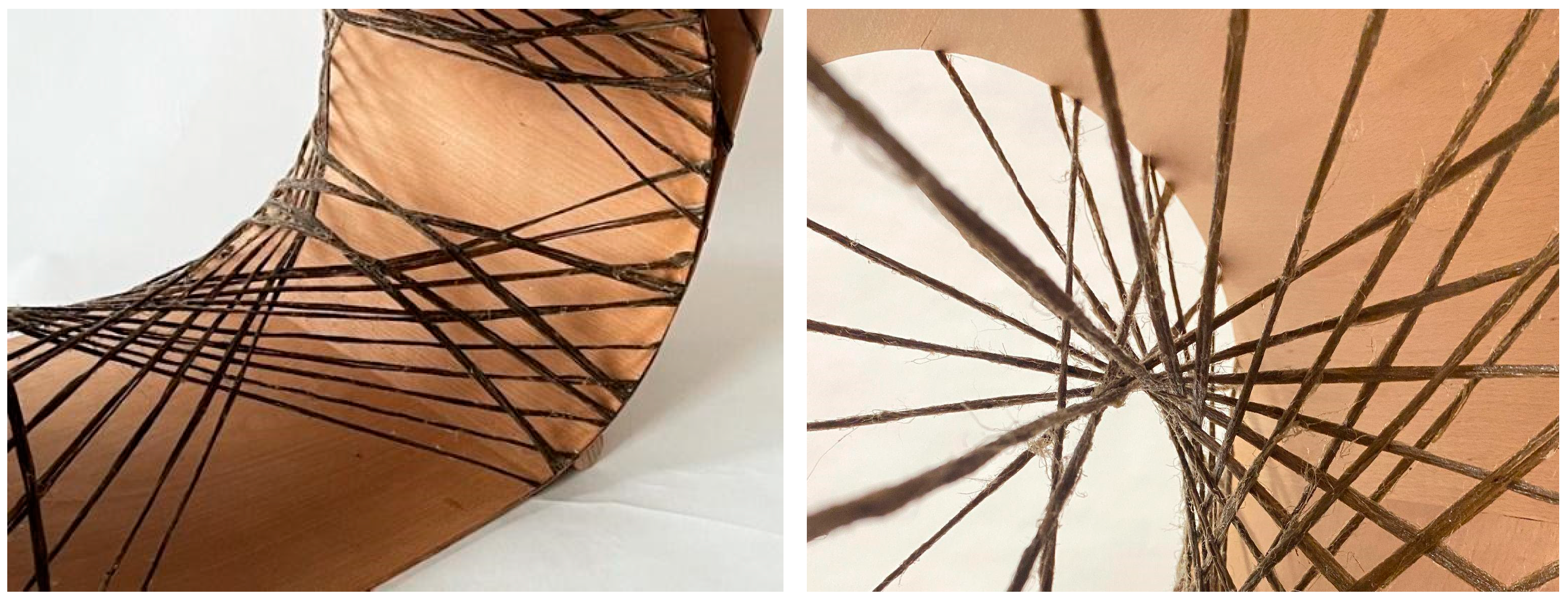
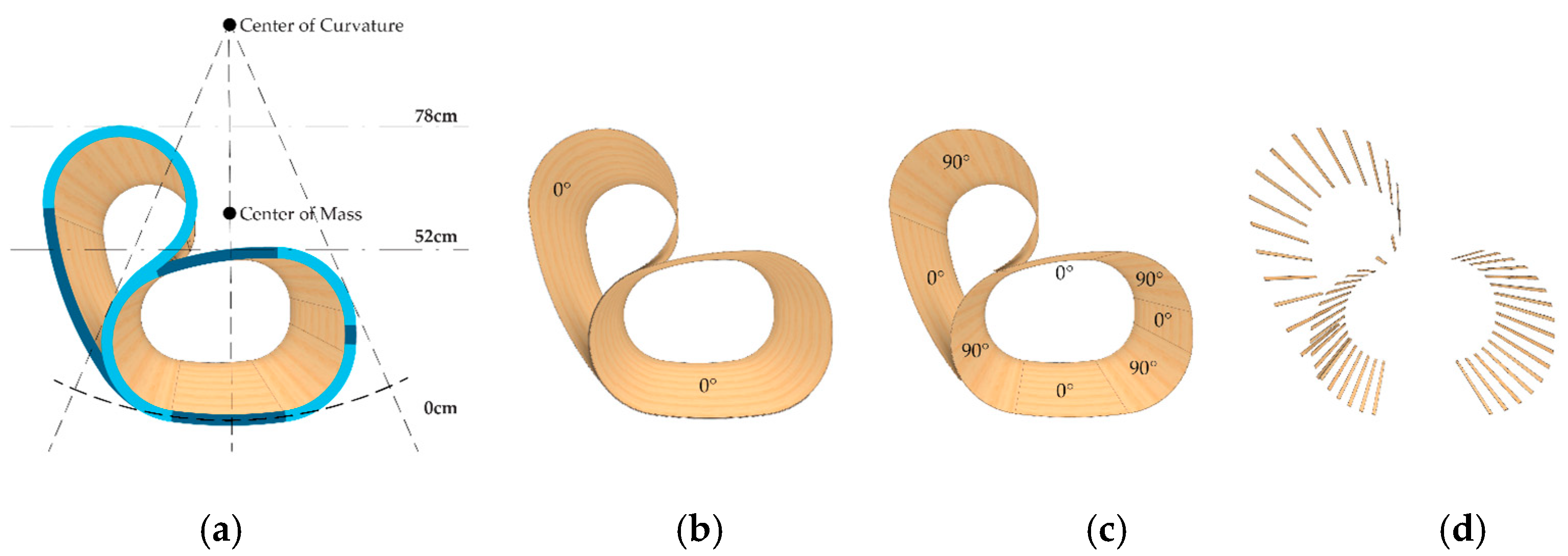


| Material | Length | Estimated Material Usage | Actual Material Usage |
|---|---|---|---|
| Beech Veneer | 8.76 m | 3780 g | 3780 g |
| Flax Fibre | 155 m | 155 g | 155 g |
| Resin Matrix | - | 350 g | 1100 g |
| Wooden Dowel Stoppers | - | 600 g | 600 g |
| TOTAL WEIGHT OF PROTOTYPE | 5.6 kg | ||
Disclaimer/Publisher’s Note: The statements, opinions and data contained in all publications are solely those of the individual author(s) and contributor(s) and not of MDPI and/or the editor(s). MDPI and/or the editor(s) disclaim responsibility for any injury to people or property resulting from any ideas, methods, instructions or products referred to in the content. |
© 2023 by the authors. Licensee MDPI, Basel, Switzerland. This article is an open access article distributed under the terms and conditions of the Creative Commons Attribution (CC BY) license (https://creativecommons.org/licenses/by/4.0/).
Share and Cite
Pittiglio, A.; Simpson, A.; Costalonga Martins, V.; Dahy, H. Fibrx Rocking Chair: Design and Application of Tailored Timber as an Embedded Frame for Natural Fibre-Reinforced Polymer (NFRP) Coreless Winding. Polymers 2023, 15, 495. https://doi.org/10.3390/polym15030495
Pittiglio A, Simpson A, Costalonga Martins V, Dahy H. Fibrx Rocking Chair: Design and Application of Tailored Timber as an Embedded Frame for Natural Fibre-Reinforced Polymer (NFRP) Coreless Winding. Polymers. 2023; 15(3):495. https://doi.org/10.3390/polym15030495
Chicago/Turabian StylePittiglio, Alexandra, Ailey Simpson, Vanessa Costalonga Martins, and Hanaa Dahy. 2023. "Fibrx Rocking Chair: Design and Application of Tailored Timber as an Embedded Frame for Natural Fibre-Reinforced Polymer (NFRP) Coreless Winding" Polymers 15, no. 3: 495. https://doi.org/10.3390/polym15030495
APA StylePittiglio, A., Simpson, A., Costalonga Martins, V., & Dahy, H. (2023). Fibrx Rocking Chair: Design and Application of Tailored Timber as an Embedded Frame for Natural Fibre-Reinforced Polymer (NFRP) Coreless Winding. Polymers, 15(3), 495. https://doi.org/10.3390/polym15030495








